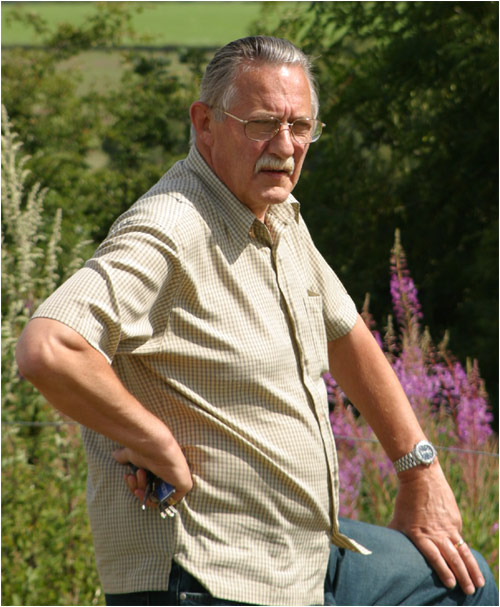 The idea to form a local astronomical society in the Mansfield / Sutton-In-Ashfield area came about in late 1969, when David Collins placed an advert in the local newspaper with the intention of contacting other people with a similar interest in the area.
The idea to form a local astronomical society in the Mansfield / Sutton-In-Ashfield area came about in late 1969, when David Collins placed an advert in the local newspaper with the intention of contacting other people with a similar interest in the area.
Following the advert, David was contacted by William Henshaw, Gordon Jones and several other people, who all met up a few days later at Davids home for an informal meeting.
At the time David worked for a local engineering company (S.A. Monks) who kindly agreed to let one of their training buildings be used to hold meetings out of working hours, so a few weeks later in February 1970 the society's inaugural meeting was held at the premesis of S.A.Monks Ltd on Mansfield Road in Sutton-in-Ashfield, attended by 12 people.
During the meeting David Collins was elected chairman, William Henshaw; Secretary, and Gordon Jones; Treasurer, and the society was formally named the "Mansfield and District Astronomical Society". A name that would later change to become the "Mansfield and Sutton Astronomical Society".
In hindsight the society was particularly ambitious; without capital support behind us we elected to construct an observatory.
The observatory was to be similar in design to another local observatory in Chesterfield, however following a discussion between members of the newly formed society, and members of the Chesterfield society, it was decided that the original plans for an 18" reflecting telescope would be expanded to a 24" design instead, and the dome would rotate electrically rather than manually.
Over the next two years, several new members joined the society, including Malcolm Roebuck, Neil Crofts and Garnett Bradshaw, all of whom have played very important roles throughout the life of the society over the last 30+ years.
After considering various locations for the proposed Sherwood Observatory, one location stood out as the most suitable, and thanks to the help of three key parties we were able to secure the present site on Coxmoor Road, on one of the highest points in Nottinghamshire.
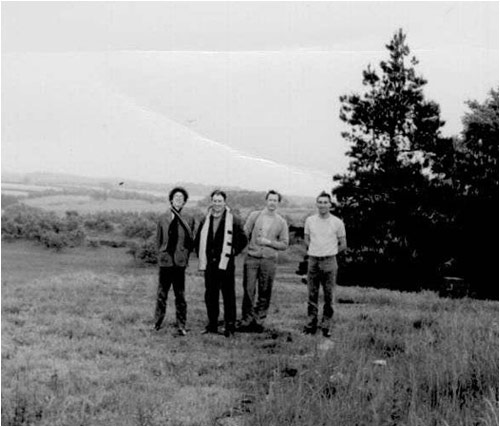 It was agreed Sherwood Observatory would include a lecture room to seat some 50 members, an observing floor on the first floor of the 22-foot diameter observatory, along with an office/control room, store, WC and kitchen/dark room on the ground floor.
It was agreed Sherwood Observatory would include a lecture room to seat some 50 members, an observing floor on the first floor of the 22-foot diameter observatory, along with an office/control room, store, WC and kitchen/dark room on the ground floor.
We submitted plans of this specification to the Council Planning Department. Further details were requested on the dome design. Nottingham University Architects Dept. welcomed the opportunity to work on this live project.
Initial site preparations commenced in 1972, and the observatory foundations were gradually dug out (in some places to a depth of over five feet).
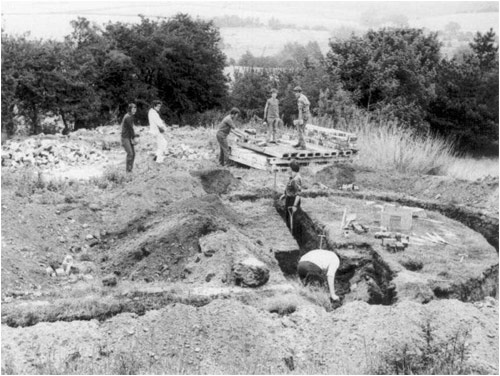
It is a testament to the committment of some of the original members, that in 1975 on the day before the foundations were due to be poured one of the members (Mr Alfred Woolrich, then 84 years of age) called at the site, only to find that part of the foundation trench had, collapsed due to heavy overnight rain. He immediately returned home by bicycle to collect some tools, then returned to the site and dug out the collapsed trench, thus enabling the foundations to be poured the following day.
Over the next eight years building materials were collected from various sources, including several thousand reclaimed bricks obtained when a local colliery canteen was dismantled, and society held fund raising events helped raise money for anything that couldn't be reclaimed.
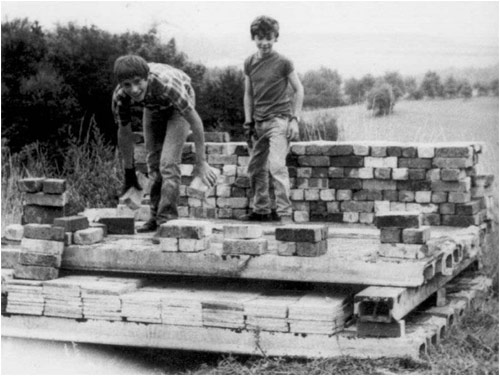
Gradually over the next couple of years the building took shape, with the brickwork being topped with a concrete ring-beam.
With the brickwork for the building complete, next came the work to build the dome, and everyone involved had to learn completely new skills. The dome itself is 22 feet in diameter, and was designed with the help of the Nottingham University Architects department.
The main ring-beam and aperture guides for the dome were made from 4x2 inch steel channeling, bent to shape by hand with the aid of a large hydraulic jack normally used lift heavy goods vehicles.
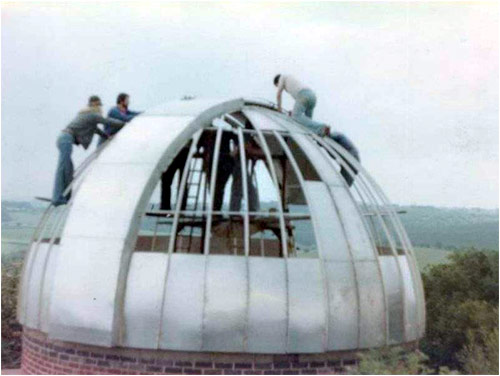 Thirty supporting ribs were then made from T-section aluminium, and 120 sheets of aluminium all individually cut and shaped by hand were fixed to the structure by over 5,000 riviets, each of which was drilled and punched by hand.
Thirty supporting ribs were then made from T-section aluminium, and 120 sheets of aluminium all individually cut and shaped by hand were fixed to the structure by over 5,000 riviets, each of which was drilled and punched by hand.
With both the lecture room roof, and now the dome complete, the building was finally weatherproof. While David Collins designed and installed the electrical sytems, Gordon Jones designed the telescope, which was then gradually built with the help of Garnet Bradshaw, and several other society members.
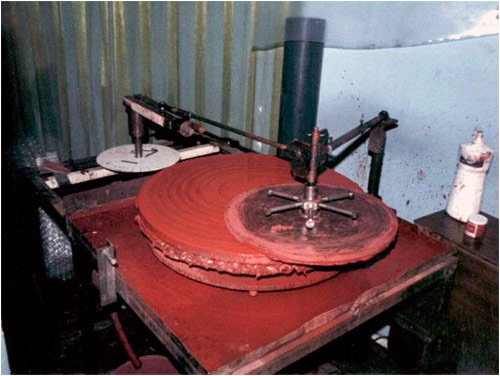 The decision was taken to hand-grind the 24" primary mirror within the observatory. This decision was abandoned when after four years of work the final mirror blank was dropped and badly chipped by a local glass company whilst silvering the surface, however work progressed on a smaller 6 inch secondary mirror.
The decision was taken to hand-grind the 24" primary mirror within the observatory. This decision was abandoned when after four years of work the final mirror blank was dropped and badly chipped by a local glass company whilst silvering the surface, however work progressed on a smaller 6 inch secondary mirror.
After much fund raising an order was placed with the Vacuum Coatings company of London, to supply a 24-inch primary mirror, and at the same time test the secondary mirror produced by the society members. Eventually the society received notification that the new primary mirror was ready for collection, and also that the tests on the secondary had proved it to be satisfactory for its intended use.
Both mirrors were duly collected, and installed in the telescope over the next few weeks, and the telescope finally saw first light with M-42 (The Great Orion Nebula) being selected as the test target.
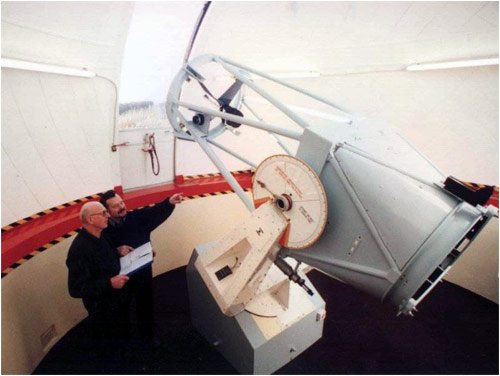
The Sherwood Observatory was finally officially opened in 1986, by the Astronomer Royal, Professor Sir Francis Graham Smith. A fitting tribute to the dedication and hard work of all of the society members during the first 16-years of the society's history.
Over the years many people and local businesses have played important roles either directly, or indirectly, in helping to make the observatory what it is today. Some of those to whom we are especially indebted are:
- The offices of Mr E Redfern (Chairman of the Sutton UDC Highways & Finance Committee).
- Mr Leah (Clerk / Treasurer to the Central Notts Water Board).
- Mr T. Paling (Paling Insurance Services).
- Mr G Chapelow (Chief Building Inspector, Sutton UDC).
- Mr Fawcett (Nottingham University Architects Department).
- Mr T Henwood of Pleasley for heavy goods transport.
- Mr Robert Copestake of Clumber Building Supplies for donating all of the block for the internal walls.
- Mr Doug Wilson for donating and installing various window frames.
- R. Staley & Son of Glapwell for the loan of a petrol driven generator.
- S. A. Monks of Sutton-In-Ashfield for providing meeting facilities, and much of the electrical systems.
- And of course the many members who have helped along the course of the 30+ year journey.
- This brief history of the Mansfield and Sutton Astronomical Society has been put together from information provided by David Collins and Gordon Jones, both of whom are founding members of the society.
Footnote
Since this article was writen, a number of society members that have been involved with the society for many years have been offered, and have accepted, honorary membership positions in recognition for the amount of time and effort they have devoted to the society over the years.


